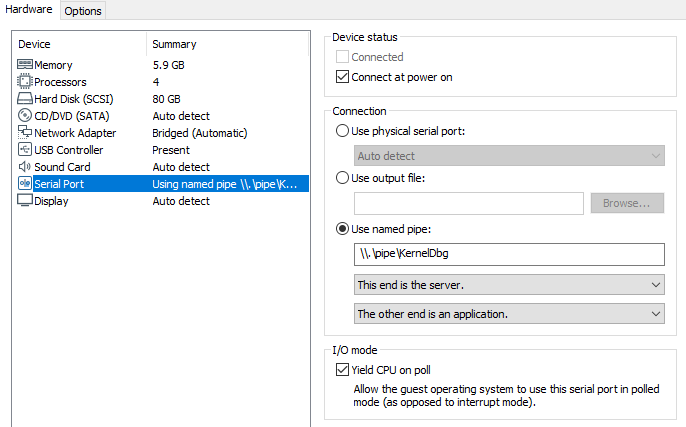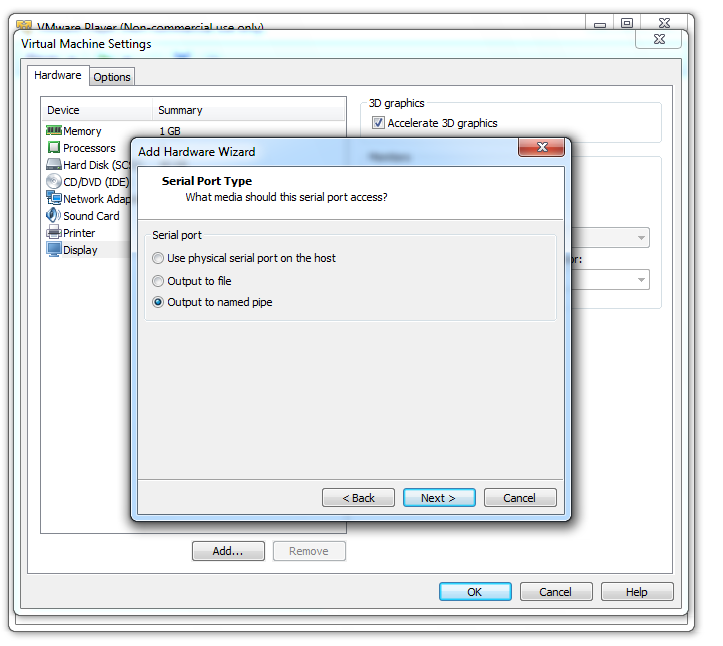Vmware Player Serial Port Named Pipe
A virtual machine in VMware Player can use up to four serial (COM) ports. They can be configured to send output to physical serial ports, files, or named pipes.
TP Link - Download Center Detail. Modifications and Bug Fixes: Driver version for 2K/XP 32Bit/64Bit changed to 7.7.0.51,Driver version for Vista 32Bit changed to 8.0.0.43. Tl wn422g driver for mac. Download TP-LINK TL-WN422G V1 & V2 Driver For Windows XP/Vista/7/8. TP-Link TL-WN422G shows excellent abilities of mitigating data loss over long distances and through obstacles in a house or apartment. You could receive best performance of this router without any lag and interference in any spot in your house. Completo de controladores y software Gratis. Descargar driver de tp-link tl-wn422g 54mbps para Windows XP windows Me OS 32 bits y 64 bits - Windows 2000, Win 10, Windows 2008, Windows 2000, Windows Vista, 7 y Mac. Tp Link TL-WN422g Driver Windows 10 Download Latest Version Os 7/8 / 8.1 / XP / Vista / 2000 32bit and 64bit, With wifi Lan, Update for improve overall performance and stability, increase transfer speeds, fix different compatibility problems and several network-related errors.
Examples: Debugging over a Virtual Serial Port
You can use Debugging Tools for Windows (WinDbg) or Kernel Debugger (KD) to debug kernel code in a virtual machine over a virtual serial port. You can download Debugging Tools for Windows from the Windows DDK Web site at www.microsoft.com/whdc/devtools/debugging/default.mspx.
The following two examples illustrate how to use a virtual serial port to debug kernel code in a virtual machine:
Using either of these methods lets you debug kernel code on one system, without the need for two physical computers, a modem or serial cable.
Debugging an Application in a Virtual Machine from the Windows Host
In this example, you have kernel code to debug in a virtual machine (called the target virtual machine) and are running WinDbg or KD on your Windows host.
To prepare the target virtual machine, follow the steps for a Windows host in Connecting an Application on the Host to a Virtual Machine. Make sure you configure the virtual machine's virtual serial port as follows:
To prepare the host, make sure you have a recent version of Debugging Tools for Windows — one that supports debugging over a pipe. You need version 5.0.18.0 or higher.
When you are ready to begin, complete the following steps:
1. Power on the virtual machine.
2. Check to make sure the serial port is connected. Choose choose VM > Removable Devices. On that menu, serial<n> should be reported as .pipe<namedpipe> (on Windows hosts) or /tmp/<socket> (on Linux hosts). If the serial port is not connected, choose the virtual serial port, then Connect.
3. On the host, open a Command Prompt window and do one of the following:
windbg -k com:port=.pipe<namedpipe>,pipe
kd -k com:port=.pipe<namedpipe>,pipe
Then press Enter to start debugging.

Debugging an Application in a Virtual Machine from another Virtual Machine
In this situation, you have kernel code to debug in a virtual machine (called the target virtual machine) and are running Debugging Tools for Windows (WinDbg) or Kernel Debugger (KD) in another virtual machine (called the debugger virtual machine) on the same host.
This is useful if you are running VMware Workstation on a Linux host. The debugger virtual machine must be running Debugging Tools for Windows (WinDbg) or Kernel Debugger (KD) in a Windows guest operating system.
To prepare the target virtual machine, follow the steps for the server virtual machine for the appropriate host in Connecting Two Virtual Machines. Make sure when you configure the target virtual machine's virtual serial port that you select the Yield CPU on poll check box, as the kernel in the target virtual machine uses the virtual serial port in polled mode, not interrupt mode.
To prepare the debugger virtual machine, make sure you have downloaded Debugging Tools for Windows. Then follow the steps for the client virtual machine in Connecting Two Virtual Machines.
When you are ready to begin, complete the following steps:
1. Power on both virtual machines.
2. Check to make sure the serial port is connected. Choose choose VM > Removable Devices. If the serial port is not connected, choose the virtual serial port, then Connect.
Sonoris DDP Player 3.0 for Mac is available as a free download on our application library. Sonoris DDP Player for Mac relates to Audio & Video Tools. Our built-in antivirus scanned this Mac download and rated it as 100% safe. This Mac application is an intellectual property of Sonoris Audio Engineering. The Sonoris DDP Creator The DDP Creator lets you assemble professional RedBook compatible audio CD’s and supports the import and export of DDP 2.00 images and Cue Sheet (cue) files. It also enables you to burn and rip audio CD’s and send off images with FTP. Sonoris DDP Creator 4.0.3.0 on Mac OS X Mavericks free. Sonoris DDP Creator DL for iMac 10.10 free hidden network. On Macos Get Sonoris DDP Creator (4.0.3.0) In Spanish. App RapidShare 10.10.2 without virus extension mac. New version google drive. Sonoris DDP Creator DL for iMac 10.10 free. Mobile-friendly online. Free sonoris ddp creator for mac. Free download Sonoris DDP Creator Sonoris DDP Creator for Mac OS X. The Sonoris DDP Creator is a standalone cross-platform CD authoring application compatible with virtually any DAW software on the market.
3. In the debugger virtual machine, start debugging with WinDbg or KD normally.
You can add up to four serial (COM) ports to a virtual machine. Virtual serial ports can output to physical serial ports, files, or named pipes.
You might want to add a virtual serial port to a virtual machine to make devices such as modems and printers available to the virtual machine. You can also use virtual ports to send debugging data from a virtual machine to the host system or to another virtual machine.
Note:The virtual printer feature configures a serial port to make host printers available to the guest. You do not need to install additional drivers in the virtual machine.
Power off the virtual machine.
Procedure
- Select the virtual machine and select VM > Settings.
- On the Hardware tab, click Add.
- In the Add Hardware wizard, select Serial Port.
- Click Finish to add the virtual serial port to the virtual machine.
- Select where the virtual serial port sends output.
Use a physical parallel port
Send output to a physical serial port on the host system.
Use output file
Send output to a file on the host system. Either locate an existing output file or browse to a directory and type a filename to create a new output file.
Output to named pipe
Set up a direct connection between two virtual machines, or a connection between a virtual machine and an application on the host system.
- If you selected Output to named pipe, configure the named pipe.
- (Windows host) Use the default pipe name, or type another pipe name.
The pipe name must begin with .pipe and must be the same on both the server and the client.
- (Linux host) Type /tmp/socket or another UNIX socket name in the first text box.
The pipe name must be the same on both the server and the client.
- To send debugging information to an application on the host system, select This end is the server from the first drop-down menu and select The other end is an application from the second drop-down menu.
- To send debugging information to another virtual machine, select This end is the server from the first drop-down menu and The other end is a virtual machine from the second drop-down menu.
- (Windows host) Use the default pipe name, or type another pipe name.
- To connect the port to the virtual machine when the virtual machine powers on, select Connect at power on.
- (Optional) On the Hardware tab, select the new serial port, select Yield CPU on poll, and click OK.
This option is useful if you are using debugging tools that communicate over a serial connection. If the serial port in the guest operating system is being used in polled mode rather than interrupt mode, you might notice performance issues. This option forces the virtual machine to yield processor time if the only task it is trying to do is poll the virtual serial port.
If you set up a connection between two virtual machines, the first virtual machine is set up as the server. Repeat this procedure for the second virtual machine, but set it up as the client by selecting This end is the client when you configure the named pipe.
